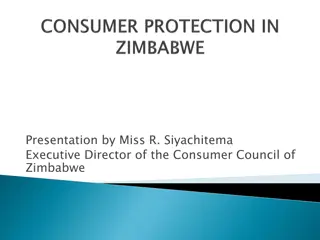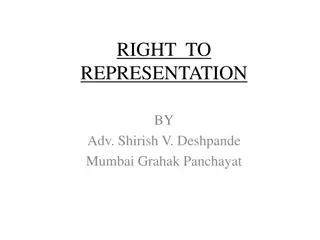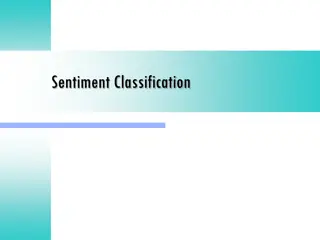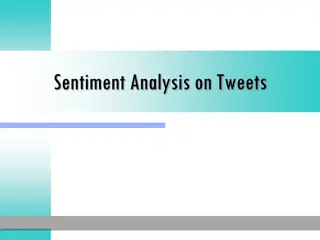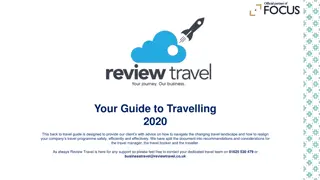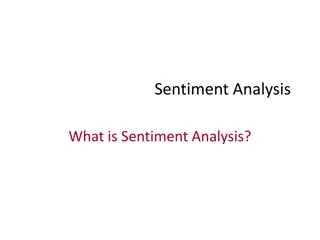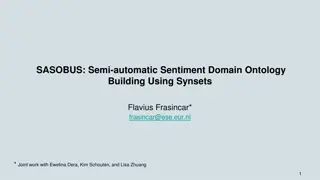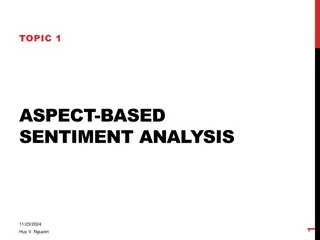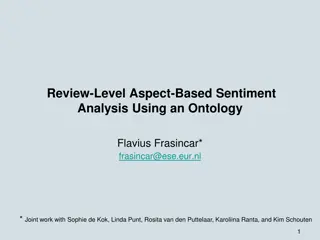COVID-19 Consumer Weekly Tracker: UK Travel Sentiment Analysis
VisitEngland, VisitScotland, and Visit Wales conduct a weekly survey to track consumer sentiment related to domestic travel intentions amid COVID-19. The survey captures data on travel likelihood, destinations, accommodations, activities, and traveler reassurances sought. Results are publicly available and updated weekly. Key metrics include general sentiment scores, perceptions of COVID-19 situation, risk assessment, normality expectations, holiday intentions, and confidence levels for short breaks and holidays.
Download Presentation

Please find below an Image/Link to download the presentation.
The content on the website is provided AS IS for your information and personal use only. It may not be sold, licensed, or shared on other websites without obtaining consent from the author.If you encounter any issues during the download, it is possible that the publisher has removed the file from their server.
You are allowed to download the files provided on this website for personal or commercial use, subject to the condition that they are used lawfully. All files are the property of their respective owners.
The content on the website is provided AS IS for your information and personal use only. It may not be sold, licensed, or shared on other websites without obtaining consent from the author.
E N D
Presentation Transcript
COVID-19 Consumer Weekly Tracker Week 7 Fieldwork Period: 29 June 3 July U.K. Results
Introduction VisitEngland, VisitScotland and Visit Wales have commissioned a weekly Covid-19 consumer sentiment tracking survey to understand domestic intent to take overnight short breaks and holidays both within the U.K. and abroad, with particular focus around the current barriers and concerns around travel and how these will evolve over time. The survey addresses: the likelihood of U.K. residents to travel; when and where they plan to go; specific trip details such as accommodation type and activities undertaken and the type of reassurances they're seeking from the sector. This tracker is based on a U.K. nationally representative sample of 1,500 adults aged 16+ with boosts for Scotland and Wales. The survey is repeated across a 13 week period with the first wave published on 1 June 2020. The results are made publicly available and updated each week at the following website: https://www.visitbritain.org/covid-19-consumer-sentiment-tracker 2
Fieldwork Periods Project Period Fieldwork Period 18 22 May Week 1 25 29 May Week 2 1 5 June Week 3 8 12 June Week 4 15 19 June Week 5 22 26 June Week 6 29 June 3 July Week 7 6 10 July Week 8 13 17 July Week 9 20 24 July Week 10 27 31 July Week 11 3 7 August Week 12 10 14 August Week 13 3
Week 7: Scorecard of Key Metrics (1) * Represents a significant change on previous week Table 1. Top line Metrics General Sentiment Scores Key Metrics Week 6 Week 7 Weekly Shift 6.7 6.6 -0.1 National mood (average score out of 10) 27% 21% -6* Perceptions of the situation regarding Covid-19 (% stating worst has passed ) 2.38 2.48 +0.1 Risk score: Comfort in undertaking a range of activities (1-4 comfort score) 17% 15% -2 Normality score (proportion expecting normality by September) The main reasons for not feeling confident about taking a trip between July- 1. Concerns about catching COVID-19 2. Fewer opportunities to eat/drink out 1. Concerns about catching COVID-19 2. Fewer opportunities to eat/drink out No change September (Top 2) Table 2. Top line Metrics General short break and holiday intentions Key Metrics Week 6 Week 7 Weekly Shift -23 -23 0 Anticipated number of U.K. short breaks compared to normal (% net) -26 -27 -1 Anticipated number of U.K. holidays compared to normal (% net) 14%/29%/43% 21%/31%/43% +7*/+2/0 UK near-term holiday/short break confidence (July/August/Sept. confident) 54% 52% -2 UK medium-term holiday/short break confidence (Oct-Dec confident) 71% 69% -2 UK long-term holiday/short break confidence (Jan 2021 onwards confident) 24% 25% +1 Proportion going on a UK short break or holiday between July-Sept 4 41%/52%/6% 46%/49%/6% +5*/-3/0 Split between holiday / short break / don t know for next trip between July-Sept
Week 7: Scorecard of Key Metrics (2) Table 3. Top line Metrics Specific short break and holiday plans * Represents a significant change on previous week Key Metrics Week 6 Week 7 Weekly Shift South West South West No change Leading England destination likely to stay in between June - Sept Countryside or village Countryside or village No change Main type of destination likely to stay in between June - Sept Caravan/camping Caravan/camping No change Main accommodation type likely to stay in between June - Sept Table 4. Top line Metrics Broader leisure activity Key Metrics Week 6 Week 7 Weekly Shift Outdoor areas Outdoor areas No change Place/activity generating highest engagement compared to normal Predominantly indoor or covered attractions Predominantly indoor or covered attractions No change Place/activity generating lowest engagement compared to normal 5
The national mood and perceptions of the situation in relation to COVID-19 The average mood of UK residents is 6.6 out of 10, back to the same level as weeks 3 to 5. 17% described their mood as 0-4/10, the highest proportion since the research began. Figure 1. Current mood out of 10, Percentage week-on-week, UK Mean Average 6.7 6.7 6.6 6.6 6.6 6.7 6.6 100 14 15 17 17 17 17 19 90 80 9-10 70 43 43 41 42 45 41 60 44 7-8 50 5-6 40 30 0-4 25 28 25 28 25 25 26 20 10 17 16 15 15 14 13 12 0 Week 1 Week 2 Week 3 Week 4 Week 5 Week 6 Week 7 6 Q5: How would you rate, between 0 and 10, your mood today? Base: All respondents. Week 1 n=1,753; Week 2 n=1,757; Week 3 n=1,753; Week 4 n=1,746; Week 5 n=1,739; Week 6 n=1,756; Week 7 n=1,757
The national mood and perceptions of the situation in relation to COVID-19 Only 21% of the U.K. population feel that the worst has passed in relation to COVID-19, the lowest levels seen yet. 41% think that the worst is still to come, significantly higher than any previous week of research. Figure 2. Perception of the situation with regards to COVID-19, Percentage week-on-week, UK 100 90 21 The worst has passed 27 24 27 29 30 31 80 70 Things are going to stay the same 60 38 38 42 38 39 37 50 38 40 The worst is still to come 30 41 20 36 35 33 33 32 31 10 0 Week 1 Week 2 Week 3 Week 4 Week 5 Week 6 Week 7 7 Q7: Regarding the situation of Coronavirus in the UK and the way it is going to change in the coming month, which of the following best describes your opinion? Base: All respondents. Week 1 n=1,753; Week 2 n=1,757; Week 3 n=1,753; Week 4 n=1,746; Week 5 n=1,739; Week 6 n=1,756; Week 7 n=1,757
Perceptions of when things will return to close to normal 15% of U.K. residents believe that life will return to something close to normal by September a number that continues to drop, and is now half of what it was in week 2. 35% think that something close to normality will return by December, a significant fall on last week. Figure 3. Perceptions of when things will return close to normal Percentage Week 7, UK Figure 4. Proportion expecting normality by September, Percentage week-on- week, UK 35% 1.4 29% 30% 27% 1.2 32% 30% 29%23% 18% 17% 15% 25% 1 20% 20% 0.8 Week 1Week 2Week 3Week 4Week 5Week 6Week 7 15% 0.6 10% 10% 7% 0.4 Figure 5. Proportion expecting normality by December, Percentage week-on-week, UK 3% 3% 5% 2% 0.2 0% 0 54% 53% 52% 49%41% 39% 35% Week 1Week 2Week 3Week 4Week 5Week 6Week 7 8 Q16: Given what you know today, when do you think life will return to something close to normal? Base: All respondents. Week 1 n=1,753; Week 2 n=1,757; Week 3 n=1,753; Week 4 n=1,746; Week 5 n=1,739; Week 6 n=1,756; Week 7 n=1,757
Level of comfort undertaking everyday activities with a comfort average The appetite for risk score stands at 2.5 out of 4 (4 representing very comfortable ), the highest score seen yet and with the biggest week-on- week increase. All 4 activities record their highest levels of comfort so far ranging from taking public transport (2.0) to going for a walk in the country (3.3). Figure 6. Level of comfort conducting a range of activities separately and combined, Average Score week-on- week where 1= not at all comfortable doing activity and 4= very comfortable doing activity, UK 4.0 3.3 3.3 3.5 3.2 3.2 3.2 3.1 3.0 3.0 2.5 2.5 2.4 2.4 2.4 2.3 2.3 2.3 2.3 2.3 2.5 2.3 2.2 2.2 2.2 2.1 2.0 2.0 2.0 2.0 1.9 1.9 1.9 1.9 1.8 1.8 1.8 1.8 1.8 2.0 1.5 1.0 Comfort average Going for a walk in a country park/ local trail Shopping in your local shopping centre Eating at a restaurant Travelling by public transport Week 1 Week 2 Week 3 Week 4 Week 5 Week 6 Week 7 VB11. Broadly speaking, how comfortable or uncomfortable would you feel doing the following in the next month or so? Base: All respondents excluding those stating don t know or who wouldn t do activity under any circumstances Mean average based on those that gave a score of 1-4. Net: comfort average is calculated as a straight average of the four scores. Week 1 n=1,753; Week 2 n=1,757; Week 3 n=1,753; Week 4 n=1,746; Week 5 n=1,739; Week 6 n=1,756; Week 7 n=1,757 9
Confidence in the ability to take a U.K. short break or holiday The number of Britons that are confident that they would be able to take a U.K. short break or holiday in July (21%) has increased significantly on week 6 (14%). This increase is driven by those who are very confident to travel in July rising from 2% in week 6 to 8% in week 7. Later time periods are largely consistent. The majority are confident they d be able to take a U.K. trip between October and December this year (52%) and from January 2021 onwards (69%) although both down slightly on week 6. Figure 7. Confidence in taking a UK short break or holiday across a range of different months, Percentage Week 7, UK 29 17 12 8 8 40 35 31 23 13 July this year August this year September this year October to December this year January 2021 onwards Fairly confident Very confident 10 QVB7anew. We d like you to imagine that you have booked a UK holiday or short break in each of the six time periods listed below. In light of the current COVID-19 pandemic, how confident are you that you would be able to go on these trips? Base: All Week 7 respondents n=1,757
Reasons for not feeling confident about taking trips in the U.K. Top 5 Concerns about catching COVID-19 is the leading reason for the U.K. public not feeling confident about travelling between July and September this year (46% of those not confident stating this), followed by fewer opportunities to eat/drink out (44%). Restrictions on travel from government (41%) is down in third in the list. From October onwards, concerns about catching COVID-19 is the leading reason again but with a higher proportion stating it at 53%. All other reasons are significantly less important. Figure 8. Top 5 reasons for not being confident about travelling between July to September, Percentage Week 7, UK Figure 9. Top 5 reasons for not being confident about travelling from October onwards, Percentage Week 7, UK 53 46 44 41 40 37 35 34 33 31 I have concerns about catching COVID-19 Restrictions on travel from government (national or devolved) It's not Fewer Personal finances I have concerns about catching COVID-19 Fewer Restrictions on travel from government (national or devolved) Fewer things to do/places to visit It's not responsible to travel in this period opportunities to eat/drink out opportunities to eat/drink out responsible to travel in this period 11 QVB8a. Which of the following factors are contributing to you being not very confident or not at all confident about taking a UK short break or holiday? Base: Week 7 respondents not confident about taking a break between July and September n=915 and from October onwards n=612.
Anticipated number of U.K. trips this year compared to normal Compared to normal, the public anticipates taking fewer short breaks (net -23) and holidays of 4+ nights (net -27) in the UK between now and the end of 2020. The net anticipation for both types of domestic trip are very consistent with week 6. Figure 10. Number of UK short breaks (1-3 nights) over the rest of this year compared to normal, Percentage Week 7, UK Figure 11. Number of UK holidays (4+ nights) over the rest of this year compared to normal, Percentage Week 7, UK 100 100 12 15 80 80 28 26 More More 60 60 About the Same About the Same 39 38 40 40 Fewer Fewer Don't know Don't know 20 20 22 22 0 0 Week 7 Week 7 12 QVB1b. Compared to normal, are you likely to take more, fewer or about the same number of UK holidays/short breaks between now and the end of the year? Base: All Week 7 respondents n=1,757
Anticipated number of OVERSEAS trips this year compared to normal U.K. adults anticipate taking fewer overseas short breaks (-38) and holidays (-36) by the end of the year compared to normal. Unlike U.K. trips, these net figures have become smaller since week 6 with people anticipating more overseas trips. Figure 13. Number of OVERSEAS holidays (4+ nights) over rest of this year compared to normal, Percentage Week 7, UK Figure 12. Number of OVERSEAS short breaks (1-3 nights) over rest of this year compared to normal, Percentage Week 7, UK 100 100 4 5 25 25 80 80 More More 60 60 About the Same About the Same 42 41 40 40 Fewer Fewer Don t know Don't know 20 20 29 29 0 0 Week 7 Week 7 13 QVB1b. Compared to normal, are you likely to take more, fewer or about the same number of overseas holidays/short breaks between now and the end of the year? Base: All Week 7 respondents n=1,757
When anticipating to plan and book next U.K. short break or holiday 44% have either already planned or intend to plan a U.K. short break or holiday by September, an increase on week 6 (41%). 37% have already booked or intend to book their trip by this time. There has been no significant change on week 6. Figure 14. When anticipate PLANNING next UK holiday or short break, Percentage Week 7, UK Figure 15. When anticipate BOOKING next UK holiday or short break, Percentage Week 7, UK Not planning at any point 21 21 Don't know but would like to January onwards 18 18 October to December 12 14 September 6 9 6 August 7 8 July 7 14 Already planned / booked 11 17 11 Week 7 Week 7 14 QVB2a. Thinking of the next UK holiday or short break you are likely to take, when are you likely to plan, book and go on this trip? Base: All Week 7 respondents n=1,757
When anticipating going on next U.K. short break or holiday 25% of U.K. adults anticipate going on their next U.K. short break or holiday by this September, slightly higher than the proportion intending to do so in week 6 (24%), and again the highest total seen so far. 35% plan on taking their next UK trip in October or later, whilst 19% would like to take a trip but are unsure when they will do so. Figure 17. Proportion expecting to go on a short break/holiday by September, Percentage week-on- week, UK Figure 16. When anticipate GOING on next UK trip, Percentage Week 7, UK Not planning at any point 21 Don't know but would like to 19 January onwards October to December 22 25% 24% September 23% 22% 22% 13 20% 19% 8 August 9 8 July Week 1 Week 2 Week 3 Week 4 Week 5 Week 6 Week 7 Week 7 15 QVB2a. Thinking of the next UK holiday or short break you are likely to take, when are you likely to plan, book and go on this trip? Base: All respondents. Week 1 n=1,753; Week 2 n=1,757 Week 3 n=1,753; Week 4 n=1,746; Week 5 n=1,739; Week 6 n=1,756; Week 7 n=1,757
When planning on taking next UK holiday or short break, by trip length Holidays of 4+ nights make up the majority of U.K. trips in July and again from October onwards (although this is largely driven by trips from Spring/Summer 2021. In August and September, trips are more likely to be short-breaks. Figure 18. Length of next UK holiday or short break by time period, Percentage Week 7, UK 100% 5 5 8 12 80% 44 41 52 48 60% 40% 52 51 43 20% 39 0% July August September October and beyond Short break (1-3 nights) Holiday (4+ nights) Unsure 16 QVB3. Is this next trip likely to be a short break (1-3 nights) or a holiday (4+ nights)? Base: All week 7 respondents intending to take next holiday in each time period July n=133, August n=144, September n=142, October and beyond n=632
Where planning on staying on next U.K. short break or holiday The South West is still significantly more likely than any other U.K. region to generate short break and holiday visitors between July and September this year (19% intending to do so). The South West is followed by Scotland (13%) and then 5 regions that generate interest from between 9% and 12% of those planning a domestic trip in this period. The South West of England, Scotland, and London are the parts of the UK most likely to generate short breaks and holidays from October. Figure 19. Where planning on staying on next UK overnight trip in July to September, Percentage Week 5-7 merged data, Top 10, UK Figure 20. Where planning on staying on next UK overnight trip from October onwards, Percentage Week 5-7 merged data, Top 10, UK 20 19 15 13 12 13 12 11 9 10 8 8 8 9 9 8 5 5 6 6 South West Scotland London North West Yorkshire & the Humber Wales South East East of England West Midlands North East South West Scotland Yorkshire Wales North West London South East East of England West Midlands East & the Humber Midlands QVB4a. Where in the UK are you likely to stay on this next trip in <INSERT MONTH FROM VB2(III)>? Base: All week 5-7 respondents planning on taking a holiday or short break in the UK between July and September n=1,163 and from October onwards n=1,958. Three weeks of research merged to increase statistical reliability 17
Main mode of transport for next U.K. short break or holiday Across both time periods, own car is still by far the leading mode of transport. Train is the second most preferred mode across both periods, although falls below 1 in 10 between July and September, followed by plane. Figure 21. Top 5 main modes of travel of destination for trip in July to September, Percentage Week 7, UK Figure 22. Top 5 main modes of travel of destination for trip from October onwards, Percentage Week 7, UK 65 57 15 9 9 6 4 4 4 3 Own car Train Plane Car-hired/taxi Motorhome/ Campervan Own car Train Plane Car-hired/taxi Public bus/coach 18 QVB4c. What do you anticipate being the main mode of travel to your holiday or short break destination? Base: All week 7 respondents planning on taking a holiday or short break in the UK between July and September n=419 and from October onwards n=632
Type of destination for next U.K. short break or holiday Countryside or village and traditional coastal/seaside town (both 33%) are the two main destination types for a trip between July and September. City or large town (23%) and rural coastline (21%) are the next most preferred destination types although significantly less so. From October onwards, countryside or village (31%), city or large town (30%) and traditional coastal/seaside town (28%) are the three preferred destination types. City or large town is significantly more likely to be selected from October onwards than from July to September. Figure 23. Main type of destination for trip in July to September, Percentage Weeks 5-7 merged data, UK Figure 24. Main type of destination for trip from October onwards, Percentage Weeks 5-7 merged data, UK 33 33 31 30 28 23 22 21 16 15 Countryside or village Traditional coastal/seaside town City or large town Rural coastline Mountains or hills Countryside or village City or large town Traditional coastal/seaside town Rural coastline Mountains or hills QVB5a. Which of the following best describes the main types of destination you are likely to stay in during your UK trip? Base: All week 5-7 respondents planning on taking a holiday or short break in the UK between July and September n=1,163 and from October onwards n=1,958. Three weeks of research merged to increase statistical reliability 19
Type of accommodation for next U.K. short break or holiday There remains a very even split in the types of accommodation people are likely to use on their trips between July and September only one percentage point splitting caravan/camping (36%), private home (35%), hotel/motel/inn (35%), and commercial rental (35%). From October onwards, hotel/motel/inn (41%) is more likely to attract visitors than any other accommodation type. Commercial rental (40%) and private home (38%) are just behind as the next preferred accommodation types for trips in this period with comfortably over a third selecting them. Figure 26. Accommodation planning on staying in on next UK overnight trip from October onwards, Net percentage Weeks 5-7 merged data, UK Figure 25. Accommodation planning on staying in on next UK overnight trip in July to September, Net percentage Weeks 5-7 merged data, UK 41 40 38 33 36 35 35 35 27 23 11 12 Hotel/motel/inn Commercial rental (e.g. rented holiday cottage) A private home Caravan/ Camping Guesthouse / B&B/ Farm house Other Caravan/ Camping A private home Hotel/motel/inn Commercial rental (e.g. rented holiday cottage) Guesthouse / B&B/ Farm house Other 20 QVB6a. What type/s of accommodation do you expect to be staying in during your UK trip in <insert month>? Base: All week 5-7 respondents planning on taking a holiday or short break in the UK between July and September n=1,163 and from October onwards n=1,958. Three weeks of research merged to increase statistical reliability
General leisure activity intentions as lockdown restrictions are lifted Outdoor areas are most likely to attract more visitors/engagement than normal (net +32), followed by outdoor leisure or sports activities (net +15) and outdoor attractions (net +14). Health or wellbeing activities (net -6), entertainment and events (net -8), and indoor attractions (-11) are likely to attract fewer visitors/engagement than normal but have all improved on week 6. Figure 27. Leisure venues and activities more or less likely to visit/do as lockdown restrictions are lifted, Net: more likely minus less likely Week 7, UK 32 15 14 -6 -8 -11 Outdoor areas (e.g. beaches, mountains, trails etc.) Outdoor leisure or sports activities (e.g. walking, cycling, swimming etc.) Predominantly outdoor attractions (e.g. theme parks, playgrounds etc.) Health or wellbeing activities (e.g. spa/ beauty, retreat or meditation, indoor swimming) Entertainment and events (e.g. restaurants, cinema, festivals etc.) Predominantly indoor or covered attractions (e.g. museums, cathedrals etc.) 21 QVB9a/bB10a/b. Which, if any, of these types of places/activities in the UK are you more/less likely than normal to visit/do as restrictions are lifted? Base: Base: All respondents Week 7 n=1,757
Conditions essential for people to stay in accommodation this summer Steps to reduce cross-contamination (72%), ensure social distancing (71%) and booking incentives (69%) are the biggest reassurances the public need when planning a stay in paid-for accommodation. Guest/staff interventions (66%) and government cleanliness standards (41%) are important but are less of a priority. Scores are consistent with week 6. Figure 28. Conditions that are essential for a stay in accommodation this summer, Percentage and Net Percentages Week 7, UK Net: Cleanliness standard Net: Guest/Staff interventions Net: Reduced contamination Net: Booking incentives Net: Social distancing measures 72% 71% 69% 66% 41% 55 52 52 46 43 43 43 43 42 42 41 35 34 33 19 17 Plentiful hand sanitizers Free Enhanced cleaning regimes Enforced social distancing Daily staff health checks Staff to wear face masks Management of communal areas (e.g. games areas, bars, restaurants, toilets etc.) Transferable bookings to a later date Contactless check-in and payments Significantly reduced capacity Government certification for complying with hygiene and distancing guidelines Daily guest health checks Guests to wear face masks Packaged food only (no open buffets) Closure of communal areas (e.g. games areas, bars, restaurants, toilets etc.) Ability to pay in instalments cancellation 22 Q63new. Which, if any, of the following conditions would it be essential for accommodation providers to have in place for you to stay at them this summer? Base: All respondents Week 7 n=1,757.
Methodology The findings in this report are based on a weekly online survey conducted amongst a nationally representative sample of the U.K. population. The sample is representative of UK adults aged 16+ by gender, age, government region and social grade. In the first stage a nationally representative core sample of 1,500 is recruited and interviewed. This sample is then boosted in Wales and Scotland to ensure sufficient base sizes for separate nation analysis. The data are then weighted to make the sample representative of the U.K. overall and within each nation. This report presents findings from Week 7 of the COVID-19 consumer weekly tracker, with comparisons to previous weeks where appropriate. Week 7 fieldwork was conducted between 29th June to 3rd July 2020. 23
Master Data Table To access a .csv file of the data contained within the charts, please open this report with Adobe Reader. When you have done so, navigate to the left hand side of the page to the attachments area, symbolised by a paperclip icon, and click on the file to open the attachment. 24






